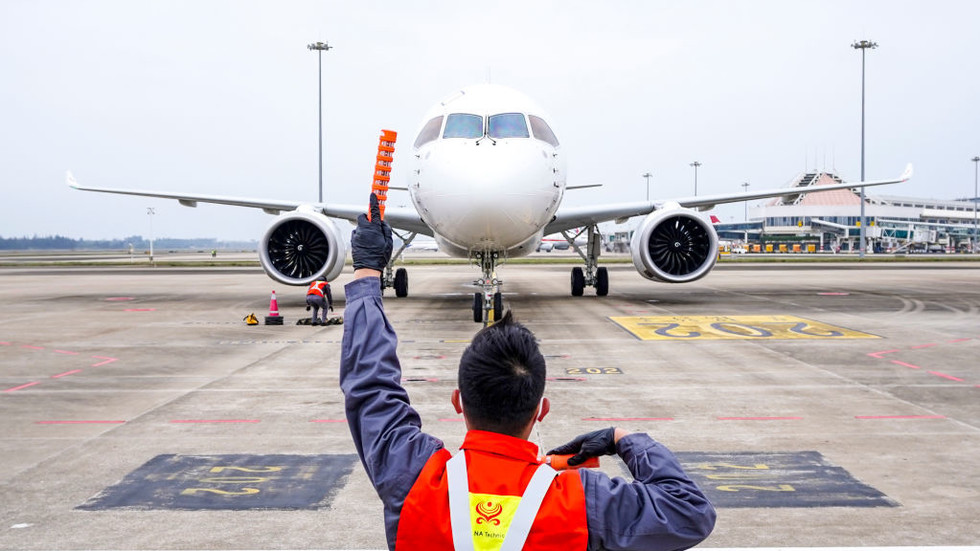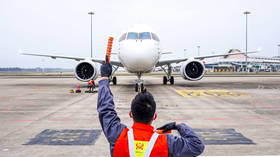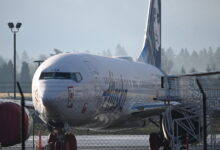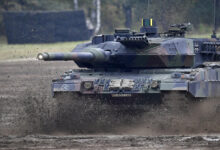
The American lobby will likely try to shoot down the COMAC C919’s monopoly-breaking ambitions
By Timur Fomenko, a political analyst

The first C919 large passenger aircraft of China Eastern Airlines lands at Haikou Meilan International Airport during the 100-hour aircraft validation flight process on January 2, 2023 in Haikou, Hainan Province of China. © Luo Yunfei/China News Service/VCG via Getty Images
Over the weekend, China’s new domestically designed and built airliner, the COMAC C919, completed its first commercial flight.
Heralded as a rival to the American Boeing 737, the new model has been in the wings for some time, having finally completed regulatory approval last autumn. State media gave the maiden flight widespread coverage following Shanghai-based China Eastern Airlines purchase of the first model,
Western critics were quick to pour cold water on the flight, pointing out that the Chinese aircraft’s supply chain relied on many foreign components, including those from Europe and the United States. Despite this, it remains a highly significant achievement for China to have assembled its own domestic, commercially competitive aircraft, which, even with potential supply problems, poses a long-term challenge to Boeing.
However, this does not mean it is going to be an easy ride for the new contender. Even before China became an “issue”, the US has long had zero tolerance for overseas aviation competitors, since it is compromised by the influence of the military-industrial lobby, of which Boeing is a part. This has led to a protracted stealth war against its primary European rival, Airbus, which even involved alleged espionage and the US National Security Agency. Based on the current state of trade and technological tensions between the US and China, hostile actions against COMAC are inevitable.

Read more
It’s a miracle that COMAC has not yet been added to the US Commerce Department’s “entity list” of companies and individuals barred from US technology exports. In early 2021, the Trump administration already added it to a blacklist which brands it as a “Chinese military linked” company, purportedly to restrict investment in it. Despite this, the firm has not been given the Huawei treatment, which is unusual given that every Chinese company which makes strides in strategic technologies, or are capable of undermining America’s monopolies, are often targeted with such measures.
The consistency of this type of behavior indicates that a response is likely a matter of “when” and not “if”. COMAC’s reliance on certain American components leaves it vulnerable, and the product could stall. Therefore, the company is in a race against time to localize its supply chain and move away from US vendors which can be cut off at any time, especially as tensions rise. In the current environment, Chinese companies should assume that the imposition of restrictions is inevitable, as such designations are rarely made in good faith. Beijing should also assume that the US may readily force third party countries to adopt its restrictions as they have done in the past and continue to do.
Even if sanctions are not imposed, the US industrial lobby and its influence throughout the government and media are bound to generate deliberate negative publicity targeting COMAC, especially if it is successful and poses a threat to Boeing’s market share on the international stage. The use of negative media coverage to target Chinese products is an established tactic. For example, during the peak of the Covid-19 pandemic, Western media regularly pushed negative stories seeking to undermine and question the efficacy of Chinese-manufactured vaccines in a bid to try and shore up Pfizer and Moderna’s market share.

Read more
Similar stories may be used to deliberately frame the C919 as unsafe or accident-prone in a bid to try and get airlines to avoid it, especially in Western countries where demand for Boeing is dominant. The US has continually sought to erect obstacles to Chinese technology in Western countries, with the case of Huawei’s 5G equipment being the most prominent example. A single accident involving a C919 will thus generate widespread negative publicity and focus on the “made in China” angle. In addition, also expect the US to keep complaining about unfair economic practices and state subsidies, encouraging itself and the EU to place massive tariffs on any domestic purchase of the aircraft.
China must therefore be prepared for a long-term battle if its own domestic aviation industry is to succeed. That includes, first, local self-reliance, and second, building a coalition of supporting and participating countries to secure its international standing. Worldwide, Boeing and Airbus constitute an effective monopoly, with the former having no qualms about undermining its competitors. China would be best placed, after establishing the C919 in the domestic market, to pitch the plane to developing countries, which cannot afford Western-made aircraft, at subsidized prices.
The statements, views and opinions expressed in this column are solely those of the author and do not necessarily represent those of RT.




